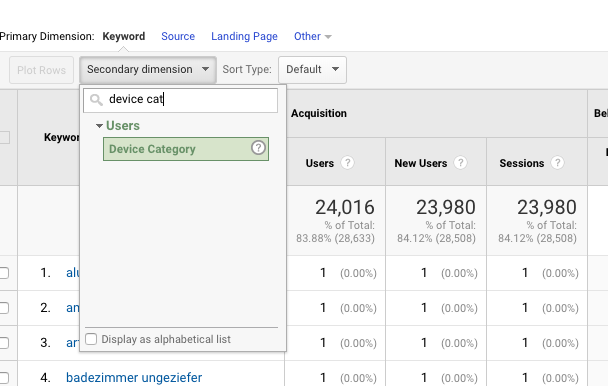Maximize Reporting Precision With Second Dimension in Google Analytics
Comprehending how to maximize reporting accuracy with secondary measurements in Google Analytics can substantially boost the deepness of understandings obtained from data analysis. By integrating second measurements tactically, marketers can uncover hidden patterns and correlations that may not be immediately evident when analyzing primary metrics alone.
Understanding Second Measurements in Google Analytics
Additional dimensions permit users to section and further explore information past the primary measurement chosen. While the main dimension might display the overall number of web page sights, adding a second dimension such as 'source/medium' can provide understandings into where the web traffic stemmed from.
Moreover, comprehending second dimensions is crucial for producing a lot more customized reports customized to details business goals. By choosing the ideal combination of main and secondary dimensions, analysts can reveal patterns, trends, and connections that might or else continue to be hidden. This nuanced approach to data analysis empowers services to make enlightened choices based upon an extensive understanding of individual habits throughout numerous measurements.

Exactly How to Use Secondary Dimensions
When leveraging secondary dimensions in Google Analytics, the practical application involves picking particular data criteria to additional improve insights beyond the key dimension's range. To apply additional dimensions properly, begin by accessing the record or dataset where you want to dig deeper right into the data. Remember that second dimensions aid supply context and granularity to your main dimension information, enabling you to extract even more workable and purposeful insights from your Google Analytics records.
Leveraging Additional Measurements for Insights
Utilizing additional measurements in Google Analytics permits an extra detailed analysis of information, providing beneficial insights beyond the main dimension's range. By leveraging secondary measurements, customers can dig much deeper into the efficiency metrics of their website or app, revealing covert patterns and patterns that might not be quickly obvious when only looking at main measurements.
One secret benefit of making use of secondary dimensions is the capability to section and filter information much more exactly. This can assist online marketers and experts much better recognize the behavior of specific user segments, such as new visitors versus returning visitors, or traffic originating from different geographic locations.
Additionally, secondary measurements enable individuals to compare and contrast various information factors within the exact same report, supplying a much more alternative view of performance (Secondary Dimension in Google Analytics). For example, matching the primary dimension of touchdown web pages with additional dimensions like devices or demographics can disclose which web pages are most efficient in involving individuals on various gadgets or from different demographic teams.
In essence, leveraging secondary measurements in Google Analytics equips individuals to visit extract richer understandings from their data, causing more enlightened decision-making and eventually, improved efficiency.
Finest Practices for Secondary Measurements
When examining information in Google Analytics, incorporating additional measurements efficiently improves the deepness of insights derived from the main metrics. Picking relevant secondary dimensions assists in offering context and a more clear understanding of the data being analyzed.
Moreover, it is advised to limit the number of additional measurements made use of in a single report to prevent frustrating the evaluation with way too much information. Concentrating on a couple of essential additional dimensions at a time can cause more concentrated and actionable insights. Furthermore, think about try out different mixes of primary and secondary measurements to reveal one-of-a-kind fads and patterns that might not appear when taking a look at the data in isolation.
Advanced Analysis Techniques With Secondary Measurements
Exploring complex data relationships with the tactical application of second dimensions can unveil nuanced understandings that elevate the deepness of analysis in Google Analytics. By incorporating additional dimensions with main data collections, advanced evaluation techniques can be employed to draw out important info.
Furthermore, secondary measurements can enhance the evaluation of conversion paths by providing added context. Comprehending the different touchpoints a more information user engages with before converting can be crucial in enhancing the consumer journey - Secondary Dimension in Google Analytics. By using second dimensions to look into specifics such as traffic sources or tools used, marketing professionals can customize techniques to target high-converting channels properly
Conclusion

To enhance data analysis and gain deeper understandings into user habits, recognizing secondary dimensions in Google Analytics is necessary - Secondary Dimension in Google Analytics. Secondary dimensions allow individuals to section and better study data beyond the primary dimension chosen. While the main measurement might present the complete number of web page sights, adding a second measurement such as 'source/medium' can offer understandings right into where the website traffic stemmed from.When leveraging second measurements in Google Analytics, the useful application involves choosing certain data specifications to additional fine-tune insights beyond the primary dimension's scope. Bear in mind that secondary dimensions help provide context and granularity to your primary dimension information, allowing you to remove even more purposeful and actionable understandings from your Google Analytics records